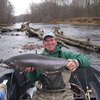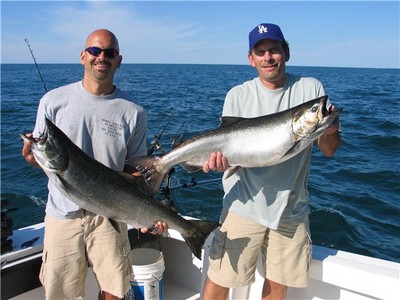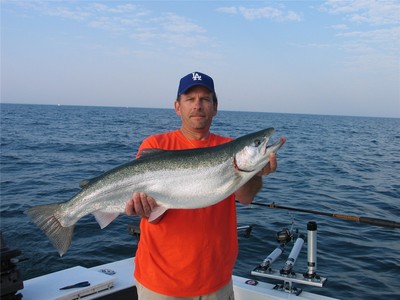This was wriitten by Captain John Oravec andJ appeared in the Summer 2008 issue of Lake Ontario Outdoors.
There we sat, mentally whipped, booked solid with fishing groups and no fish! All we could figure once upon a summer time in Lake Ontario's past was that persistent north winds had stacked deep warm water against our favorite ledges.
Seated around an umbrella table was Capt. Jim Shoey, Capt. Joe Swift, both nomads in from Sodus, Capt. Ron Penna and the late Capt. Butch "Shongo" Tiberio and yours truly. We decided then that we had to move out farther, much farther, to find fish so there had to be a plan! The five boats would fan out, set up at two hundred fifty feet of water trolling north to six hundred with radios on. The plan B would be to compare notes later in port.
Today, much more is understood about how Lake Ontario set up offshore in the summer months. There are keys to locating open water salmonids developed by many trolling pioneers around the big lake, keys that once understood, will put you on the "good water" when venturing offshore this summer.The Offshore World
I like to define the lake into three zones using overall depth as the primary marker so to me the inside water extends to 150 fow, the mid water reaches 250 fow and offshore is the zone beyond 250 feet. At first glance from the Lake Ontario Parkway, the water at the horizon just sits there. We have learned that winds can push tracts of open water from different directions stacking warm water or upwelling cold water onto ledges, no doubt! Even better we now know that it is the offshore zone that maintains stability and lots of silver fish during their peak summer feed. The definite signs to look for out deep that will put you on the hot fish. By becoming a better hunter offshore, you can eliminate dead water, get on the fish and enjoy!
Get ready to .hunt!There's thousands of square miles to whittle down out there so planning is the first key to offshore success! Your boat needs search tools including GPS, surface temperature and down temperature monitors, a reliable VHF radio and a high powered fish finder. I like to keep a note pad, binoculars and polarized sunglasses for spotting as well. You are basically hunting on the run as well as while trolling so be ready and organized. One special note about offshore fishing is to maintain the buddy system out there. Always keep with the fleet, make sure you have weather information monitored, all safety equipment and knowledge to get back to port. By monitoring local radio channels, you'll expand the hunt, while maintaining contact with the fleet. We are talking about finding King Salmon, steelhead and Coho, prime silver game fish so read on!
Signs to Read
Surface Slicks
One of the more visible signs of fertile water are the surface slicks spotted often on Lake "O". These rivers on the top of the lake are a result of wind force, wave action and collisions of water masses. The slick appearance may be a result of turbulence, different water densities and surly flotsam that flattens the surface texture. Offshore slicks indicate a sure sign that baitfish and predators are nearby. As you learn to look at the water more closely, you'll see that feathers, twigs, wood, bug skins, weeds and even sitting birds can be clues. You are crossing a boundary, a fence line on the offshore prairie, the herd could be nearby. Once again you need to quickly take a depth reference, save numbers and heygrab that rod!Plankton VeilsI first spotted so called "static" lines on my Sitex graph over 350 feet of water off Point Breeze, Orleans County, during the 1980 summer season. I learned later that I was seeing submerged layers of colonial algae dense enough to echo back like lake bottom. The plankton looked like a dark shroud over the depths so we nicknamed the picture a veil. Out of curiosity then and necessity now, wise offshore trollers camp out on veil lines to find the mother load. As in the case of slicks, naturally trolling across the underwater structure, make sure to allow the veil to sink well below the thermo cline level as you troll further offshore. Then in typical "O" fashion turn back, reset trolling ground and down speed and start crisscrossing this thermal/veil intersect while zooming in the temperature level on the sonar screen. Don't be surprised if minor gain adjustments are also needed to mark baitfish inside the veil shadow. These veils are similar to slicks just submerged, so the troll tactic is to lace them with troll passes. When you start recognizing the fish holding potential of these subtle streaks you are offshore fishing, instead of blind trolling. See Diagram #1
Surface Temperature Breaks
Early offshore pioneers along with researchers led by Dr. Mike Voiland of Cornell Cooperative Extension defined surface temperature edges on Lake Ontario. After so many seasons of educated fishing pressure, finding "hard" breaks can put you on a pile of fish. Even before leaving home for a summer trip, check the thermal set up of your water on coastwatch.msu.edu, printing the local map for reference on the boat. There is Latitude/Longitude overlay so you can enter a starting point on the GPS before leaving the dock. You can count on hot breaks to set up in early summer as the thermal bar migrates warm water offshore against cold "core" water out deep. Rapid seasonal warm up features winds the crunches cold and warm water edges together for massive 5-10+ degree surface ridges marked by dense trash lines. Most of your board action will be on the warm side but be careful crossing hard breaks as debris is a hazard; you're a long way from home! Minor breaks usually exist inside the bar indicated by .5 to 5 degree changes, and lesser slicks. Here expect good top 30 ft action on a mix of board and rigger/slider tactics. Keep the fish finder scanning shallow for sign of high bait clouds, now turn down the radio and fish!
Then anytime during the summer inshore upwelling events from hard east winds shove fish and bait offshore. On the surface border there will be terrific high action by finding transition between inshore cold areas and the stable offshore thermo cline zone, then as westerlies return a down break to set up when the warm water sloshes back. If you have ever wondered why experienced Lake Ontario trolling boats show boards at the ready all season long, wonder no more! Be rigged, ready and react to changing conditions!
The Lake Ontario Bait Raft
The ultimate fishing destination is a huge bait raft extending for miles anchored by stable summer weather. The number of king salmon, steelhead and Coho feeding on a stable raft will number in the thousands. A fellow writer, the eloquent Matt Straw, once called wide strands of alewife an oasis for salmonids in desert water. It is not unusual to have multiple bands at say, 3, 6 and 9 plus miles out, so pick your water and go. These areas are the summer feeding grounds for our fishery, enjoy the action, but please maintain high minimum length standards. Major bait lines are usually reported on hotlines and websites like attheoak.com in the western basin. Now take a look at diagram # 2 for a closer look at a bait raft. Anytime you find such water expect aggressive feeding chromers that will crush a tweeked spoon program. The fun more than justifies the hunt!
Staying On FishStitching a Seam of Fish
My number one priority day today is being on active fish as soon as possible each time out. Once youve searched up a prime area out there staying on the picture sounds easy, but conditions change quickly so here's some tricks to maximize your fun. I'd like a gallon of gas for every time I see boats leave fish or complain that "it's a slow pick". Sometimes a more aggressive trolling pattern on fish rafts will turn a pick into a flurry and flurries into chaos!
Wander trolling northwest two miles across an area then two miles back southeast takes time and autopilots are part of this type of trolling, that's cool! Now me, when I hook up on an active picture, I'll recall numbers and be on my way back to a waypoint before I net this one. Not only that, when I've seen enough fish on an east west line, I will stitch that seam of fish with the same down speed/troll course as others, but my passes are considerably shorter staying constantly on the raft. It's called a steering wheel, don't be a follower, spin your boat, recall and return to the hotspot. Check out diagram #3 to see what I mean.
Yank, Run and SetAnytime there is choppy, windy conditions, you stand a chance of getting pushed off the hotspot. Rough conditions can make the reverse troll difficult and fruitless and basically a waste of time. Here-in is one of the top 10 reasons I love my Subtroll 900. This analogue meter style displays real time variations in the boats momentum. When beating your way back, your speed must be steady to maintain consistent lure action. If my Subtroll is racing then stalling way above and below the target range its time to yank, run and reset. No one ever said that once a troll is started the cannonballs must stay wet until quitting time.
Come on, there's hungry fish back there a mile, so pull the spread, make a sandwich, recall some waypoints, turn on the wiper and cruise. I like this break in the action for many reasons. During the plow back I can make changes and go over the strategy for the reset. Remember too that it takes time to rerig, get speed and troll angle so bust pass the hotspot so your rigs are down upon arrival to the waypoint. The other benefit to YR&S tactics on blowy days is in keeping closer to port and the pack.
Lure Presentation Out DeepPower trolling a matched spoon set on downriggers during the summer offshore season is tons of fun. Densely schooled Coho, steelhead and Chinook are on a daily alewife gorging routine at this time so rig downriggers with short leads with group enhancing spoon sliders pinned or free to cover the fish/alewife level. If you've done your fish finding homework this tight school illusion set is all you'll need to get busy!
Opinions vary port to port on the hottest spoon blades out there, but one opinion of mine has stood the test of time. Always troll a matched set of quality spoons. This is rule #1 for successfully finding the hot trolling speed/troll course that will keep the rods flying. The fish activity is high at this time so stay with the Silver Streak, Fishlander, DW's and the best offshore power trolling spoon, the Northern King # 28. Do your homework on the net, phone and hotlines for the crushing color patterns du jour! There's one pattern that works all of the time, the O's alewife, come down to my dock and I'll show it to you.
The most important tools for this sport are the down speed gauge and your compass. By checking for snappy lure action boat side every time the troll changes direction during "stitch" trolls over alewife rafts you'll keep the drags screaming and the net wet this summer, go get em! Troutman out!
Capt. John Oravec celebrates his 30th year as a guide, writer and fishing educator. "Guiding is my passion", working the lower Niagara River from Dec. 15th-April 15th, Lake Ontario May - Sept., then shifting to the St. Lawerence River in the fall. John, aka the "Troutman", has written for In-Fisherman since 1980 and recently contributed to an ESPY award winning Great Lakes Fishing video with IF. John is available at 1-800-443-2510 or captjohnoravec.com for guided trips and seminar speaking, as well as any questions pertaining to this article.




